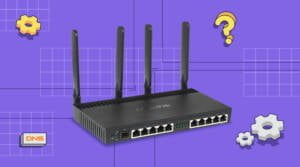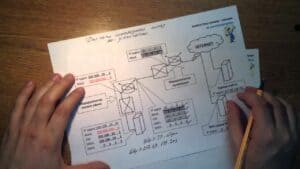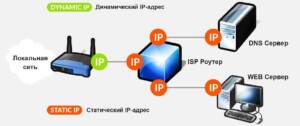How does DHCP work?
DHCP (Dynamic Host Configuration Protocol) is a network protocol that automatically assigns IP addresses and other network connection settings to devices on a local network. DHCP simplifies network configuration and reduces the chance of errors when manually entering configuration data. When a device connects to a network, it sends a DHCP request to a DHCP server. The DHCP server responds to the request by providing the device with an IP address, subnet mask, default gateway address, and DNS server address. The DHCP server can also assign other settings, such as the lifetime of the leased IP address and TCP/IP protocol parameters. The DHCP server can assign IP addresses to permanent devices on the network (for example, a printer or router) or lease them for a certain time for temporary devices (for example, for guest devices). The DHCP server can also update the network connection settings of devices when they change, for example, when the device moves to another part of the network. DHCP greatly simplifies network management and allows you to quickly configure new devices. However, you need to monitor your DHCP server settings to avoid IP address conflicts and other network problems. DHCP is a protocol that automatically assigns network devices IP addresses and other parameters necessary to connect to a network. DHCP simplifies network administration because it does not require you to manually enter each IP address for each device. DHCP also prevents IP address conflicts that can occur if two devices use the same address. DHCP works like this: When a device connects to a network, it sends a request to obtain an IP address. The DHCP server returns a free address and other parameters such as subnet mask, gateway address and DNS server. This process automation makes network administration more efficient and convenient.
DHCP is a protocol that automatically assigns IP addresses and other network parameters to devices on a network. It simplifies the process of setting up and managing a network, providing a number of benefits.
First, DHCP reduces the likelihood of network configuration errors. Instead of manually assigning each device an IP address, DNS server, and default gateway, DHCP can do this automatically. This reduces the likelihood of configuration errors, making life easier for network administrators.
Secondly, DHCP allows you to quickly change network settings. If you need to change network settings, such as the default gateway IP address, you can easily do this through a DHCP server rather than manually changing settings on each device on the network.
Finally, DHCP allows you to optimize the use of IP addresses on your network. A DHCP server can dynamically assign IP addresses to only those devices that currently need them. This allows you to use available IP addresses more efficiently and avoid IP address conflicts.
Overall, DHCP is an essential network management tool that simplifies the process of setting up and managing a network, reduces the likelihood of errors, and optimizes the use of IP addresses.
DHCP (Dynamic Host Configuration Protocol) is a protocol that allows devices to automatically obtain IP addresses, gateways, and other network settings. If you want to configure DHCP on your device, follow these simple steps:
1. Go to your device's network settings. This can usually be done through the control panel or Wi-Fi or Ethernet settings.
2. Find the section with DHCP settings and switch it to 'on' mode.
3. Set the range of IP addresses that can be issued, for example, from 192.
168.
1.
2 to 192.
168.
1.
254.
4. Set the gateway address and DNS server address if necessary.
5. Save the changes and restart the device.
Your device will now automatically receive network settings from the DHCP server. This is very convenient, especially if you have many devices on your network and do not want to configure each of them manually.
What problems can arise when using DHCP?
Although DHCP is a convenient and efficient way to automatically assign IP addresses, there may be some problems when using it. Some of them include:
1. Network Congestion: If there are many devices running on your network, the DHCP server may be overloaded and will not be able to assign an IP address to all devices.
2. IP Address Conflict: If two devices receive the same IP address, it may cause network connection problems.
3. Security breach: If an attacker gains access to the DHCP server, he can change network settings and even intercept data.
4. Configuration errors: Incorrect DHCP server configuration can cause network problems and loss of connection to devices.
5. Limited Control: If you use DHCP, you don't have full control over which devices access your network.
All these problems can be solved by properly configuring the DHCP server and regularly monitoring the network.
DHCP and IP addresses: how are they related?
DHCP (Dynamic Host Configuration Protocol) is a protocol that automatically assigns IP addresses to devices on a network. An IP address is a unique identifier for a device on a network that allows it to exchange data with other devices.
When a device connects to the network, it sends a request to obtain an IP address. A DHCP server located on the network allocates a free IP address and assigns it to the device for a certain time.
The DHCP server can also assign other parameters such as subnet mask, gateway address and DNS server, which allows devices to fully operate on the network.
With the DHCP protocol, network administrators can manage IP addresses on a network, avoiding address conflicts and providing flexibility in network configuration.
What are the alternatives to DHCP?
DHCP is a protocol that automatically configures IP addresses and other network settings on devices connected to a local network. However, there are alternatives to DHCP that can be used in different situations.
One alternative to DHCP is static IP address assignment. This method of setting up a network requires manual work, but allows precise control over which devices receive which addresses. Static IP address assignment can also be useful for devices that do not support DHCP.
Another alternative to DHCP is the Zeroconf protocol. This protocol automatically configures IP addresses and other network settings for devices connected to the local network, without the need for a DHCP server. Zeroconf also allows devices to find each other on a local network and exchange data.
Some network devices can also use protocols like BOOTP (Bootstrap Protocol) or RARP (Reverse Address Resolution Protocol) to automatically configure the network. However, these protocols are rarely used, and DHCP remains the most common way to configure a network.
Depending on the needs and characteristics of your network, you can choose one of the DHCP alternatives or stay with DHCP if it best suits your situation.
Static IP address: what is it and how to configure it?
A static IP address is an address that does not change over time and is constant for a device. This is different from a dynamic IP address, which can change each time a device connects to a network.
To set up a static IP address, you first need to know which address to use. This may be an address provided by your ISP or an address you choose. Typically, a static IP address is configured on the router that manages the network.
To set up a static IP address, you first need to go into your router's settings. This can be done by entering the router's IP address in your browser. Then find the network settings section and select the 'Static IP address' option.
Next, enter the IP address you want to use, as well as other required settings such as subnet mask and default gateway. After entering all the values, save the settings and reboot the router.
Your device will now use a static IP address instead of a dynamic one. This can be useful if you want to have a permanent address for remote access to the device or for setting up certain applications and services.
However, be aware that a static IP address may be less secure than a dynamic one, as attackers can use it to attack your network. Therefore, if you are not confident in your knowledge of network security, it is better to use a dynamic IP address.
What is BOOTP and how is it different from DHCP?
BOOTP (Bootstrap Protocol) is a protocol used to load an operating system on a computer using a network. It was developed in 1985 and is designed to configure network devices before they are loaded. BOOTP uses UDP port 67 for the server and 68 for the client.
DHCP (Dynamic Host Configuration Protocol) is a protocol that provides automatic configuration of IP addresses, subnet masks, gateways, and other network parameters. It was developed in 1993 and is commonly used to configure computers on local area networks. DHCP also uses UDP ports 67 and 68.
The main difference between BOOTP and DHCP is that BOOTP requires manual configuration while DHCP provides automatic configuration of network parameters. In addition, DHCP has broader functionality, such as dynamically changing the network configuration and the ability to work with a large number of devices.
Overall, DHCP has become a more popular and convenient protocol for configuring network settings than BOOTP. However, some devices still use BOOTP for certain tasks, such as booting the operating system on computers without a hard drive.
Read further:






